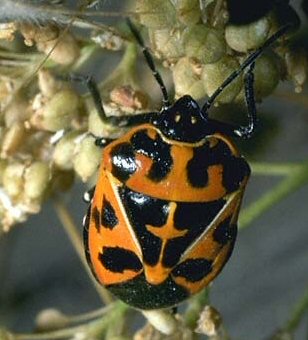Harlequin Bug
 Scientific Name
Scientific Name
Murgantia histrionica
Hosts
These bugs attack nearly all crucifers, including common weeds of the mustard family such as wild mustard, shepherdspurse, and peppergrass. If infestations are heavy and food becomes scarce, they will also feed on squash, com, beans, asparagus, okra, tomato, and many other plants.
Symptoms
Adults and nymphs pierce stalks, leaves, and veins with their needlelike mouthparts and extract plant juices. Stems and leaves injured in this manner develop irregular cloudy spots around the puncture wound. Young plants are likely to wilt, turn brown, and eventually die, while older plants are only stunted.
Life Cycle
Harlequin bugs overwinter as adults among plant debris. Adults emerge early in the spring, usually during April in Oklahoma. About two weeks after resuming activity, females begin depositing eggs on the undersides of leaves. Eggs are laid in double-row clusters of 10 to 13 until each female has deposited about 155 eggs. In early spring, eggs hatch in about 20 days. They hatch in 4 to 5 days as the weather becomes warmer. Nymphs feed for 6 to 8 weeks before becoming adults. There are three or four generations per year.
Description
This black, shield-shaped stink bug is brightly colored with orange, red, and yellow markings. It is about 3/8 inch long. The eggs are barrel-shaped, less than 1/16 inch long, and are laid in clusters. Each egg is light gray to pale yellow with two black bands, one at the top and the other near the bottom, and a black spot just above the lower band. Immature bugs are similar to the adult in coloration but are smaller and lack wings.
Control
Please contact your local county extension office for current information.

